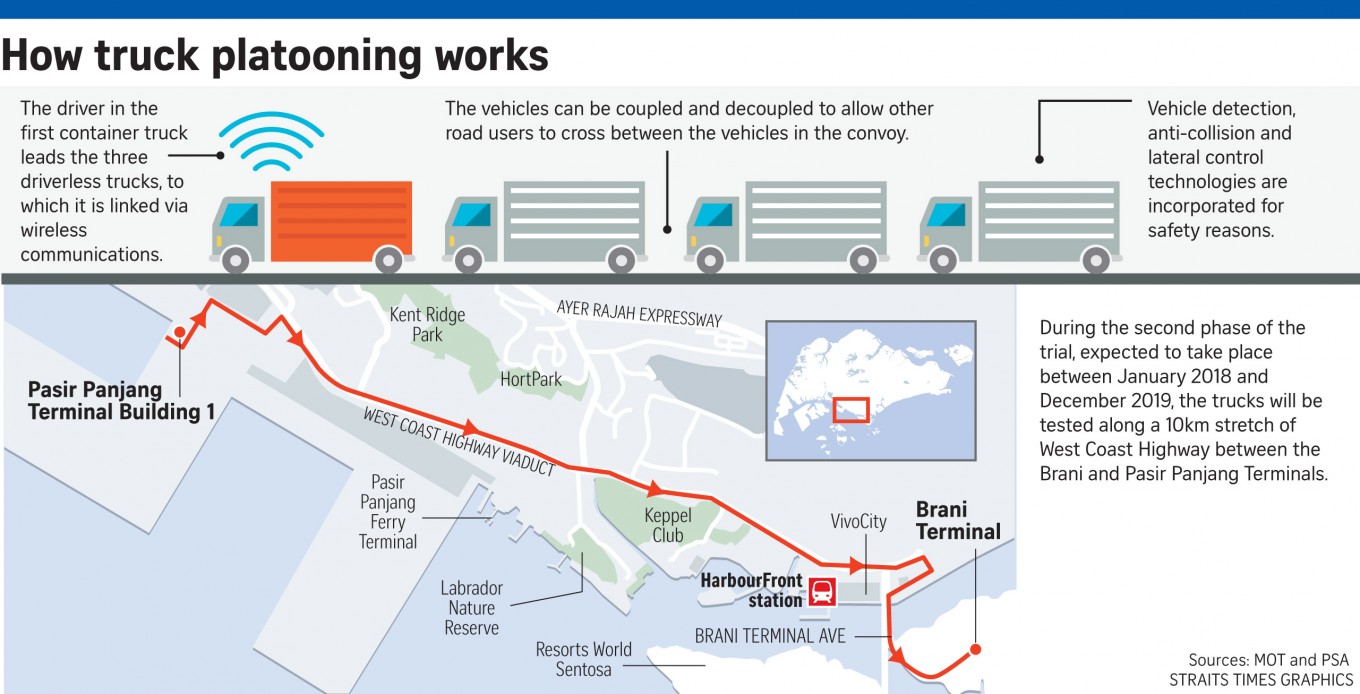Popular Reads
Top Results
Can't find what you're looking for?
View all search resultsPopular Reads
Top Results
Can't find what you're looking for?
View all search resultsDriverless trucks may be tested in Singapore soon
Change text size
Gift Premium Articles
to Anyone
D
riverless trucks may be tested on the roads here within three years, the Ministry of Transport (MOT) and PSA Corporation announced yesterday, following the signing of agreements with automakers Scania and Toyota Tsusho.
The two companies will design, develop and test a truck platooning system, in which a human-driven truck leads a convoy of driverless trucks via wireless communications, for use on the roads.
A request for proposals for the trial was issued by MOT and PSA in October 2015.
The initiative is expected to address the manpower shortage in the trucking industry, as well as ease traffic congestion by allowing more freight to be moved at night.
Both companies were chosen for their "strong track record" in both truck manufacturing and self-driving technology development, the MOT and PSA said in a joint statement yesterday.
 How truck platooning works.(Strait Times Graphics/File)
How truck platooning works.(Strait Times Graphics/File)
Autonomous trucks from Scania travelled more than 2,000km from Sweden to the Netherlands in April last year, as part of a truck platooning challenge organised by the Dutch government.
Last September, Toyota Tsusho, the trading arm of the Toyota Group, won a grant from Japan's Ministry of Economy, Trade and Industry to conduct such tests.
(Read also: Uber riders in Pittsburgh get a taste of driverless future)
The trials for Singapore will take place in two phases over a three- year period beginning this month.
The first phase, to be conducted over a year at Scania's and Toyota's research centres in Sweden and Japan respectively, will focus on the designing, testing and refining of the technology.
In order to qualify for the second phase, the truck platooning systems must meet certain criteria, an MOT spokesman said in response to queries from The Straits Times.
These include operating safely when a manned vehicle comes in between the platoon or when the lead vehicle has to make an emergency stop.
Only one of the firms will be selected for the second phase, which will test the system along a 10km stretch of West Coast Highway, between the Brani and Pasir Panjang Terminals, in various conditions, such as during rainfall and at night.
The trial may also eventually expand to include truck platooning between Pasir Panjang and Tuas Port, a distance of about 20km.
Permanent Secretary for Transport Pang Kin Keong said the introduction of truck platooning provided "an opportunity to boost productivity" in both the port and trucking sectors. "It will also open up opportunities for truck drivers to take on higher-skilled roles as fleet operators and managers," said Mr Pang, who is also chairman of the Committee on Autonomous Road Transport for Singapore, set up in 2014 to chart the direction for self-driving technology here.
PSA International's regional chief executive officer for South- east Asia Ong Kim Pong said the agreements underscored MOT and PSA's "joint commitment to being future-ready" and that truck platooning would allow PSA to better serve its customers.
The technology is taking off elsewhere as well. Last October, a truck developed by Otto, a self-driving technology start-up owned by Uber, travelled driverlessly for almost 200km in the US state of Colorado.
SIM University senior lecturer in urban transport Park Byung Joon said autonomous trucks might face fewer hurdles than self-driving cars in being introduced on the roads here. "The routes are more contained and the movement of the vehicles is more predictable," he said.
This article appeared on The Straits Times newspaper website, which is a member of Asia News Network and a media partner of The Jakarta Post











